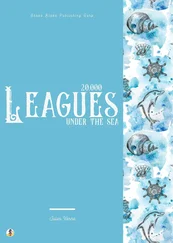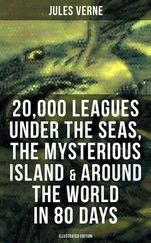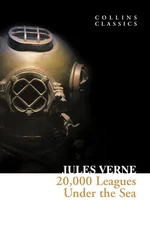Жюль Верн / Jules Verne
Двадцать тысяч лье под водой / Twenty Thousand Leagues Under the Sea
© Матвеев С. А., адаптация текста, коммент., и словарь, 2019
© ООО «Издательство АСТ», 2019
The year 1866 was marked by a bizarre development, an unexplained phenomenon that surely no one has forgotten. It must be said that professional seamen were especially alarmed. Traders, shipowners, captains of vessels, skippers, and master mariners from Europe and America, naval officers from every country, and the various national governments on these two continents, were all extremely disturbed by the business.
What happened? Several ships had encountered “an enormous thing” at sea, a long spindle-shaped object, sometimes giving off a phosphorescent glow, infinitely bigger and faster than any whale.
The relevant data on this apparition agreed pretty closely as to the structure of the object or creature in question, its unprecedented speed of movement, its startling locomotive power, and its unique vitality. No naturalists would have accepted the existence of such a monster sight unseen—specifically, unseen by their own scientific eyes.
On July 20, 1866, the steamer Governor Higginson [1] the Governor Higginson – «Говернор Хигинсон» ( название судна )
encountered this moving mass five miles off the eastern shores of Australia. Captain Baker [2] Baker – Бейкер
at first thought he was in the presence of an unknown reef; but two waterspouts shot out of this inexplicable object and sprang hissing into the air some 150 feet. Similar events were likewise observed in the Pacific seas [3] in Pacific seas – в водах Тихого океана
, on July 23 of the same year, by the Christopher Columbus [4] the Christopher Columbus – «Христофор Колумб» ( название судна )
. Both ships had observed the object at two places separated by a distance of more than 700 nautical leagues [5] nautical league – морское лье (1 лье = 5556 м)
.
Fifteen days later and 2,000 leagues farther, the Helvetia [6] the Helvetia – «Гельвеция» ( название судна )
, running between the United States and Europe, had seen the monster in latitude 42 degrees 15’ north and longitude 60 degrees 35’ west of Greenwich.
One after another, reports arrived that profoundly affected public opinion. In lighthearted countries, people joked about this phenomenon, but such serious, practical countries as England, America, and Germany were deeply concerned. In every big city they sang about the monster in the coffee houses, they ridiculed it in the newspapers, they dramatized it in the theaters. They even reprinted reports fromancient times: the views of Aristotle and Pliny [7] Aristotle and Pliny – Аристотель и Плиний
accepting the existence of such monsters, and so on.
During the first months of the year 1867, the question seemed to be buried, when new facts were brought to the public’s attention. But now it was no longer an issue of a scientific problem to be solved, but a quite real and serious danger to be avoided. The question took an entirely new turn. The monster again became an islet, rock, or reef, but a runaway reef, unfixed and elusive.
On March 5, 1867, the Moravia [8] the Moravia – «Моравиа» ( название судна )
met a rock marked on no charts. This accident happened around five o’clock in the morning. The officers examined the ocean with the most scrupulous care. They saw nothing, and the Moravia continued on course apparently undamaged. What was it? They were unable to say.
Three weeks later the accident had been reenacted under identical conditions. At 4:17 in the afternoon, when the passengers of the Scotia [9] the Scotia – «Шотландия» ( название судна )
gathered in the main lounge, a collision occurred. At first the passengers were quite frightened, but their Captain hastened to reassure them. There was no immediate danger.
Later the engineers proceeded to inspect the ship, which had been put in dry dock. They couldn’t believe their eyes. Two and a half meters below its waterline, there gaped a symmetrical gash in the shape of an isosceles triangle! This breach in the sheet iron was perfectly formed. It was truly inexplicable.
From this moment on, any maritime casualty without an established cause was charged to the monster’s account. Thanks to the “monster”, travel between the various continents had become more and more dangerous, and the public spoke up and demanded straight out that the seas were to be purged of this fearsome creature at all costs.
During the period in which these developments were occurring, I had returned from a scientific expedition. Being an Assistant Professor at the Paris Museum of Natural History, I had been attached to this expedition by the French government. After spending six months in Nebraska, I arrived in New York laden with valuable collections near the end of March. My departure for France was set for early May. In the meantime, I was busy classifying my mineralogical, botanical, and zoological treasures. That’s when that incident took place.
I was perfectly abreast of this question, which was the big news of the day. I had read and reread every American and European newspaper. This mystery puzzled me. Finding it impossible to form any views, I drifted from one extreme to the other.
Only two possible solutions to the question were left: on one side, a monster of colossal strength; on the other, an “underwater boat” of tremendous motor power. Although the latter hypothesis was completely admissible, that a private individual had such a mechanism at his disposal was less than probable. Where and when had he built it, and how could he have built it in secret?
Only a few governments could own such an engine of destruction, and it was possible that, unknown to the rest of the world, some nation could have been testing such a fearsome machine. But this hypothesis collapsed in the face of formal denials from the various governments. Since the transoceanic travel was suffering, their sincerity could not be doubted. Besides, how could the assembly of this underwater boat have escaped public notice?
And so the question of the monster surfaced again, and the human imagination soon got caught up in the most ridiculous ichthyological fantasies.
After I arrived in New York, several people did me the honor of consulting me on the phenomenon in question. In France I had published a two-volume work, in quarto, entitled The Mysteries of the Great Ocean Depths . This book had established me as a specialist in this obscure field of natural history. My views were in demand. And I had to explain myself straight out. “The honorable Pierre Aronnax [10] Pierre Aronnax – Пьер Аронакс
, Professor at the Paris Museum,” was summoned by The New York Herald to formulate his views.
Since I could no longer hold my tongue, I discussed the question in its every aspect, both political and scientific, and this is an excerpt from the article I published in the issue of April 30.
“Therefore,” I wrote, “after examining these different hypotheses one by one, we are forced to accept the existence of an extremely powerful marine animal.
Читать дальше










